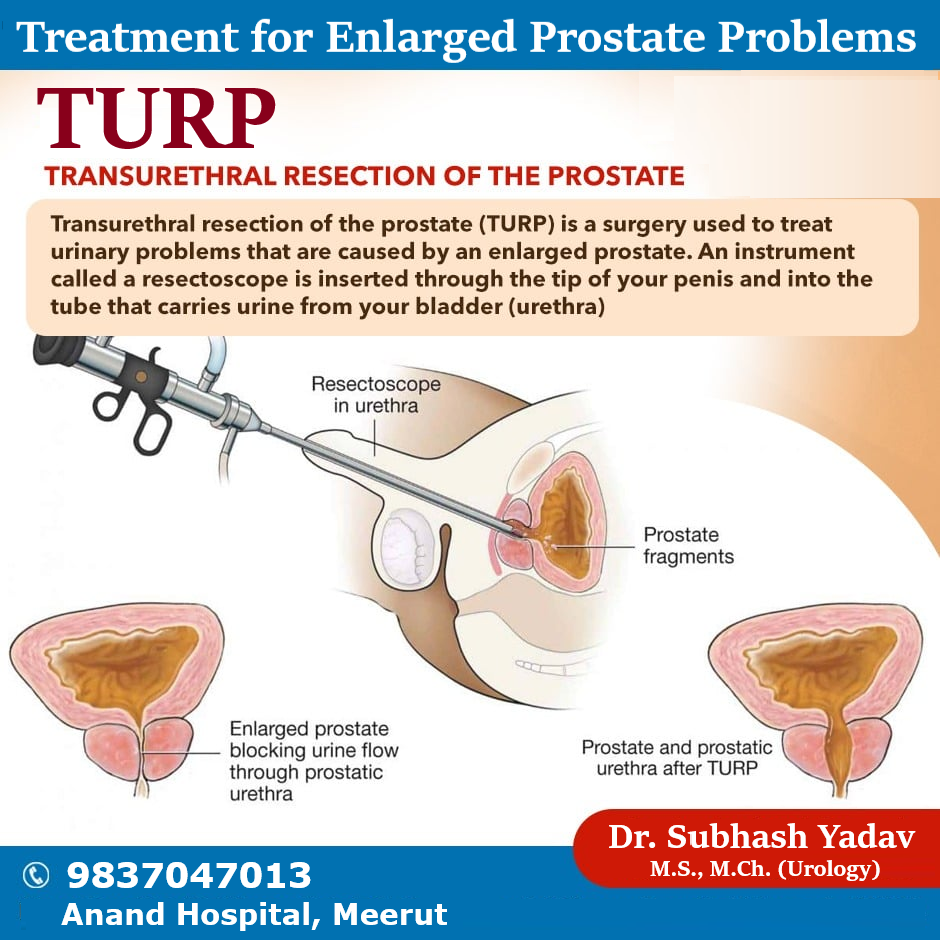What is a transurethral resection of the prostate (TURP)?
The prostate gland is found only in males. It sits below the bladder and wraps around the
urethra. The urethra is the tube that carries urine out of the body. The prostate helps produce semen.
A transurethral resection of the prostate (TURP) is surgery to remove parts of the prostate gland through the penis. No incisions are needed.
The surgeon reaches the prostate by putting an instrument into the end of the penis and through the urethra. This instrument, called a resectoscope,
is about 12 inches long and .5 inch in diameter. It contains a lighted camera and valves that control irrigating fluid. It also contains an electrical
wire loop that cuts tissue and seals blood vessels. The wire loop is guided by the surgeon to remove the tissue blocking the urethra one piece at a time.
The pieces of tissue are carried by the irrigating fluid into the bladder and then flushed out at the end of the procedure.

Why might I need TURP?
TURP is most often done to relieve symptoms caused by an enlarged prostate.
This is often due to benign prostate hyperplasia (BPH). BPH is not cancer. It is a common part of aging. When the prostate gland is enlarged, it can
press against the urethra and interfere with or block the passage of urine out of the body.
Sometimes a TURP is done to treat symptoms only, not to cure the disease. For example, if you are unable to urinate because of prostate cancer,
but surgery to remove the prostate is not an option for you, you may need a TURP.
There may be other reasons also.
How do I get ready for a TURP?
Some things you can expect before the procedure include:
What happens during TURP?
TURP requires a hospital stay. Procedures may vary depending on your condition and your healthcare provider practices.
Generally, a TURP follows this process:
What happens after TURP?
In the hospital
After the procedure, you may be taken to a recovery room and watched closely.
Once your blood pressure, pulse, and breathing are stable and you are alert, you will be taken to your hospital room.
You may get pain medicine as needed, either by a nurse, or by giving it yourself through a device connected to your IV line.
Once you are awake, you may start to drink liquids. You will be able to eat solid foods as you are able to handle them.
The catheter will stay in place for 1 to 3 days to help urine drain while your prostate gland heals. You will probably have blood in your urine after surgery.
A bag of solution may be attached to the catheter to flush the blood and potential clots out of your bladder and the catheter.
The bleeding will slowly decrease, and then the catheter will be removed.
Arrangements will be made for a follow-up visit with your healthcare provider. Your healthcare provider may give you other instructions after the procedure,
depending on your situation.
At home
Once you are home, it will be important to drink lots of fluids. This helps to flush out
any remaining blood or clots from your bladder.
You will be told not to do any heavy lifting for several weeks after the TURP. This is to help prevent bleeding.
You may be tender or sore for several days after a TURP. Take a pain reliever for soreness as recommended by your healthcare provider.
You should not drive until your healthcare provider tells you to. Other activity restrictions may also apply.
Tell your healthcare provider to report any of the following:
Your healthcare provider may give you other instructions after the procedure, depending on your particular situation.